When it comes to engineering applications, it's essential to assess materials in detail to ensure optimal performance and longevity. Choosing engineering plastic fasteners made from Link Upon can help you achieve production efficiency and maintain the integrity of your process systems.
In this blog post, we will introduce the often-referenced material characteristics and advantages of Link Upon engineering plastic screws. We will discuss their physical and chemical properties, including temperature resistance, chemical resistance, and mechanical strength, among others. We will also illustrate how these properties impact product performance and selection. Lastly, we will summarize the four major advantages that make Link Upon engineering plastic screws stand out in the semiconductor front-end-of-line process equipment market, offering reliability and efficiency.
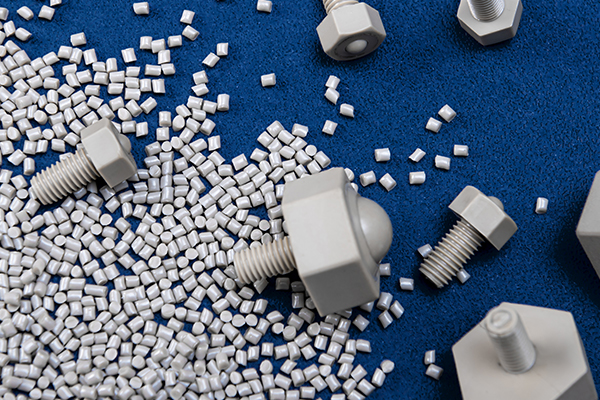
Compared to general-purpose plastics such as polyethylene (PE), polypropylene (PP), polystyrene (PS), and polyvinyl chloride (PVC), engineering plastics typically offer better heat resistance, rigidity, toughness, or long-term creep resistance. As a definition of ENPLAs: “High-performance plastics which are suitable for structural applications and machine parts and components, and industrial purposes, with heat resistance exceeding 100°C." Some consider plastics with a long-term temperature resistance exceeding 150°C as high-performance engineering plastics. Most high-temperature-resistant polymers have an aromatic structure, which provides rigidity and higher strength to the polymers. These high-strength and high-temperature-resistant engineering plastics include polyphenylene sulfide (PPS), polysulfone (PSU), polyethersulfone (PES), polyarylsulfone (PAS), polyetherimide (PEI), polyamide-imide (PAI), polyetheretherketone (PEEK), polyetherketone (PEK), liquid crystal polymers (LCP), and PA6T copolymers, among others. Apart from these, other engineering plastics include TPX polyolefin (4-methylpentene), PC (polycarbonate), and various fluorocarbon polymers such as polytetrafluoroethylene (PTFE), polyvinylidene fluoride (PVDF), ethylene-tetrafluoroethylene copolymer (ETFE), polychlorotrifluoroethylene (PCTFE), and perfluoroalkoxy (PFA).
The performance of engineering plastic materials can be evaluated based on the following properties:
1. Thermal properties: These include a high glass transition temperature (Tg) and melting point (Tm), a high heat deflection temperature (HDT), a high long-term use temperature, a wide range of temperature use, and a low thermal expansion coefficient.
2. Mechanical properties: These include high strength, a high modulus of elasticity, low creep, wear resistance, and fatigue resistance.
3. Other properties: These include chemical resistance, excellent electrical properties, weather resistance, and good dimensional stability.
Let's examine three different engineering plastic resins: PEEK, PPS, and PVDF.
PEEK (Polyetheretherketone)
Physical and Chemical Properties:
Temperature Resistance:
PEEK maintains stability in high-temperature environments, with a long-term use temperature of 240°C (464°F) and short-term tolerance of up to 300°C (570°F). It exhibits excellent flame retardancy (UL94 V-0), low outgassing characteristics, and retains its hydrothermal stability, allowing for continuous use in steam at 315°C, surpassing other engineering plastics' performance.
Chemical Resistance:
PEEK demonstrates outstanding chemical resistance, resisting acids, alkalis, organic solvents, and corrosive gases. This makes it stable in extreme chemical environments, and it remains unaffected by corrosion.
Mechanical Strength:
PEEK possesses excellent mechanical properties, with a tensile strength of approximately 90 MPa (13,000 psi) and a modulus of around 3.6 GPa (530,000 psi). Compared to other fluoropolymer resins, PEEK's mechanical performance is significantly higher under the demand for chemical resistance. See the table below for a comparison:

This makes PEEK an ideal choice for high-pressure and high-load industrial machinery components.
Wear Resistance:
PEEK exhibits excellent wear resistance, allowing components to maintain stability in high-wear environments, prolonging their lifespan, particularly suitable for mechanical components and screw applications.
Low Dielectric Constant:
Low-dielectric plastics are used in high-frequency electronic equipment, communication systems, and optical fiber communication. As electronic components shrink, PEEK's low dielectric coefficient can address issues with energy loss from high-frequency radio communication, affecting chip circuit yield. Low dielectric plastics contribute to faster and more efficient signal transmission and lower energy consumption. See the reference table below:

Applications:
Aerospace Applications:
For lightweight applications, PEEK can be used in clamps for securing wires inside aircraft, reducing weight to improve fuel efficiency.
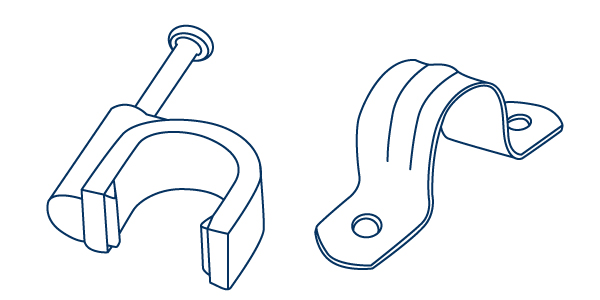
Semiconductor Manufacturing:
PEEK screws play a critical role in semiconductor manufacturing equipment, ensuring process reliability with high-temperature stability and chemical resistance, while avoiding electrical interference. Application: cleaning processes in IC manufacturing engineering.
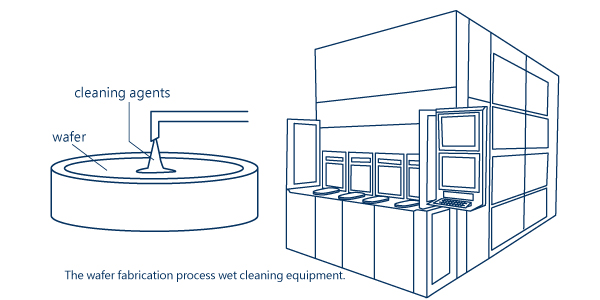
Laboratory:
PEEK-made hand-tightening fittings require no wrenches or specialized tools for installation, are easy to use, and can be tightened by hand. Due to its resistance to acid and alkali corrosion, hydrolysis and boiling, chemical resistance, high and low-pressure resistance, wear resistance, high strength, and toughness, it can be used for a long term at 240°C, widely used in various equipment and instrument pipeline connections or liquid transport applications.
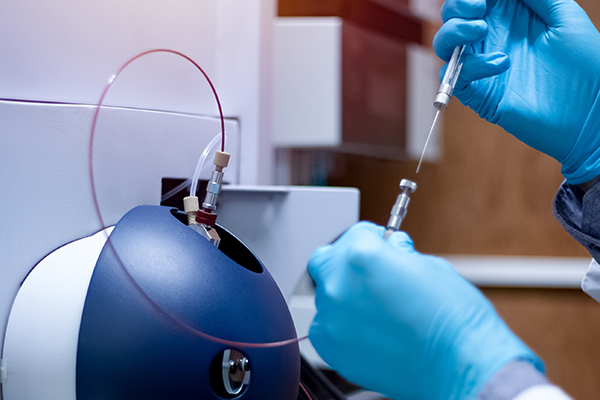
Next, let's look at PPS, a thermoplastic specialty engineering plastic:
PPS (Polyphenylene Sulfide)
Physical and Chemical Properties:
When traditional nylon plastics fail to meet requirements, aromatic polymers like PPS can be chosen. With excellent chemical corrosion resistance at high temperatures, PPS can be compared to PEEK and fluoropolymers. It can withstand continuous temperatures of up to 200°C (392°F). PPS with added glass fiber exhibits significantly higher rigidity (see the table below), with equivalent or better heat resistance, flame resistance, chemical resistance, and dimensional stability.

Heat Stability:
PPS demonstrates excellent thermal properties for both durable and short-term use. It exhibits outstanding stability at high temperatures, with a high melting point and heat deflection temperature (approximately 280-300°C), maintaining mechanical performance in high-temperature environments. It also shows excellent dimensional stability in most environments.
Chemical Resistance:
PPS has superior resistance to acids, alkalis, and organic solvents, making it suitable for applications requiring high chemical resistance.
Electrical Insulation:
PPS exhibits excellent electrical insulation properties, suitable for areas requiring electrical insulation, such as electronic components. Linear high-molecular-weight PPS, with low ionic impurities, can be used as an insulating material for printed circuit boards.
Mechanical Strength:
PPS exhibits excellent mechanical strength and rigidity, maintaining outstanding performance even at high temperatures.
PPS screws:
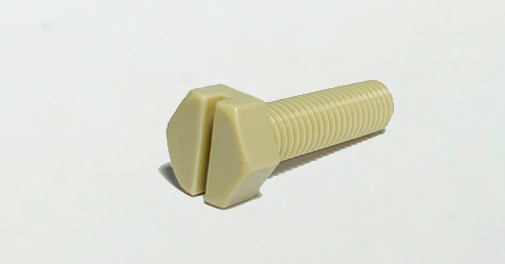
Thermoplastic specialty engineering plastic PPS is known for its high-temperature resistance, corrosion resistance, and superior mechanical properties, as well as electrical performance and dimensional stability; suitable for applications such as electronic and electrical components, automotive parts, and chemical machinery components
Now, let's take a look at PVDF, a fluorine-based engineering plastic that is widely used in lithium-ion batteries for electric vehicles (EVs):
PVDF (Polyvinylidene Fluoride)
Physical and Chemical Properties:
Crystallinity:
PVDF is a highly crystalline polymer material, with ordered molecular chains that give it excellent mechanical properties and thermal stability. This material can withstand continuous use temperatures of up to 150°C (302°F).
Melting Point and Heat Deflection Temperature:
PVDF has a relatively high melting point (approximately 170-175°C) and a high heat deflection temperature (115-130°C). This allows PVDF to maintain stability at elevated temperatures, resisting deformation or softening.
Physical Density:
PVDF has a relatively low physical density among fluorocarbon polymers, making it a lightweight, high-performance material suitable for applications requiring weight reduction.

Excellent Chemical Resistance:
PVDF is widely used in the chemical industry due to its outstanding chemical resistance. Here's a detailed analysis of PVDF's chemical resistance:
Stability to Acids
PVDF exhibits excellent stability to various acidic media, including sulfuric acid, hydrofluoric acid, nitric acid, etc. This makes PVDF an ideal choice for handling acidic chemicals, such as in chemical process pipelines operating in acidic environments.
Stability to Alkalis
PVDF also shows excellent stability to alkalis, resisting damage from alkaline media such as sodium hydroxide, potassium hydroxide, etc. This makes PVDF suitable for applications involving alkaline chemicals, such as containers for manufacturing alkaline solutions.
Stability to Organic Solvents
PVDF demonstrates outstanding resistance to organic solvents, with high stability against solvents like acetone, toluene, dimethylformamide, etc. This reliability makes PVDF very suitable for handling organic substances in processes such as containers and pipelines in the chemical industry.
PVDF homopolymers can serve as adhesives for the positive electrode materials in lithium-ion batteries. When electrolytes are combined with polymers like polyethylene oxide (PEO), polypropylene oxide (PPO), polyvinylidene fluoride (PVDF), etc., they form a gel electrolyte used in stacked lithium polymer batteries. In recent years, due to increasing environmental awareness worldwide, demand for lithium-ion batteries, especially from electric vehicles, has continued to grow.
Antioxidant Properties
The molecular structure of PVDF provides it with excellent antioxidant properties, making it resistant to oxidation from substances like oxygen and ozone. This helps maintain stable performance over long-term use.
Applications:
PVDF's outstanding chemical resistance makes it suitable for various applications, including but not limited to: chemical process pipelines, chemical storage tanks, acid-alkali neutralization systems, corrosive gas treatment, etc.
PVDF fasteners exhibit the stability characteristics of fluorinated polymers when exposed to harsh chemical and ultraviolet environments, with mechanical performance much stronger than PTFE or PFA polymers. PVDF fasteners also perform well in applications requiring high purity and low permeability, such as pharmaceutical and semiconductor processing."
The characteristics of the three materials PEEK, PPS, and PVDF are shown in the table.
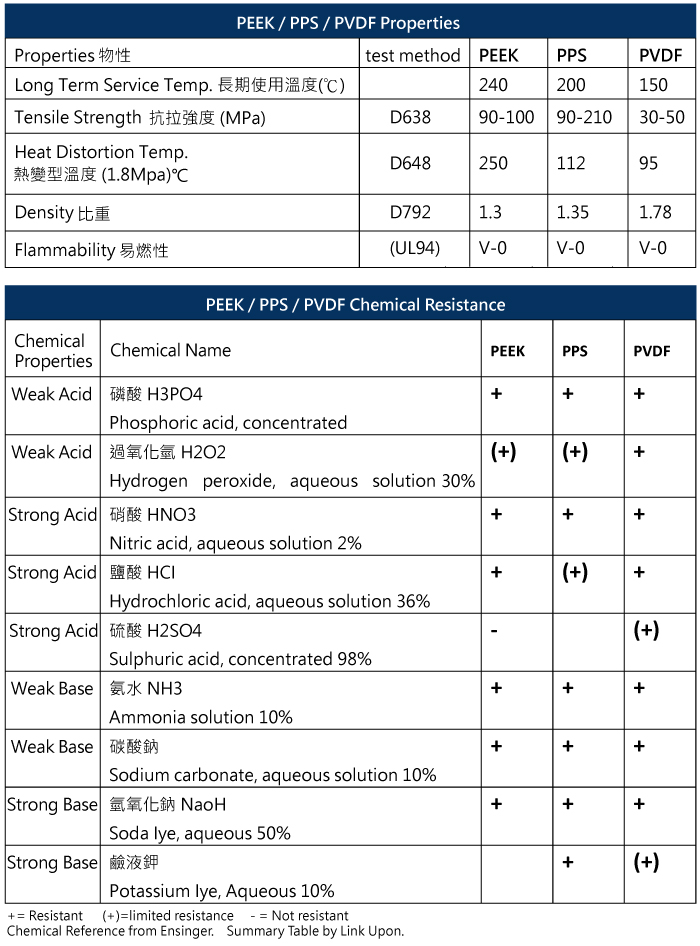
“Consistent and robust product quality control”
The physical properties of engineering plastics are superior to those of general-purpose plastics, but they are harder to process. This is especially true for complex-shaped parts where poor processing can cause internal stress or weak points that affect the final product's functionality. To produce high-quality and stable engineering plastic screws, it's crucial to control the thermal history, which includes molding process temperature and mold temperature. Link Upon provides a complete industrial manufacturing solution, which includes digitized production processes from design to testing, to ensure consistent and robust product quality control.
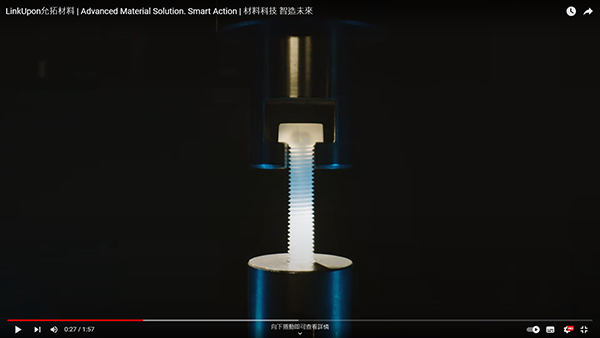
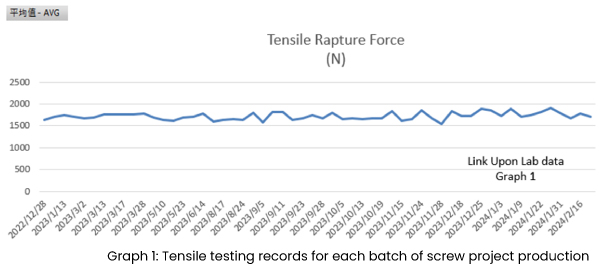
Find out other capabilities https://www.youtube.com/watch?v=HSHtsi-MPKs
Four major advantages make Link Upon engineering plastic screws stand out in the semiconductor front-end-of-line process equipment market, offering reliability and efficiency.

1. Link Upon has created a range of more than 1000 specifications of engineering plastic screws. This extensive range enables the company to cater to the diverse needs of customers, saving them time and effort in finding suitable screws. Customers can now enjoy a one-stop solution with Link Upon.
2. Industry 4.0 and digital transformation: This empowers us to enhance the intelligence and visuality of the production process. This not only boosts production efficiency but also enables proactive identification and mitigation of potential product quality issues, consequently elevating yield rates and ensuring product quality.
3. Reputation and Reliability: Link Upon has earned a solid reputation within the semiconductor sector. By adopting optical sorting equipment for appearance quality control instead of traditional manual sorting methods, we have significantly improved precision and reliability in inspection processes. This commitment ensures that the products delivered to our customers consistently adhere to the highest quality standards.
4. Link Upon has integrated tailored machinery and jigs to streamline the production process. These automated procedures, supplanting manual labor, have resulted in a notable 30% uptick in Overall Equipment Effectiveness (OEE). This innovative technology has substantially slashed production costs, allowing us to provide competitively priced products.
In summary, Link Upon considers consistent quality, smart manufacturing, reputation, reliability, and cost-effectiveness as the fundamental competitive advantages of our engineering plastic screws. We tackle production challenges and contribute to improving efficiency and quality, propelling your business to the next level.
Link Upon offers engineering plastic fasteners in both metric and inch standards, boasting a selection of over a thousand different sizes. Detailed product information can be found in the "Products & Services" section on our website. For specific product requirements, please do not hesitate to reach out to us directly.
We are more than happy to assist you.
